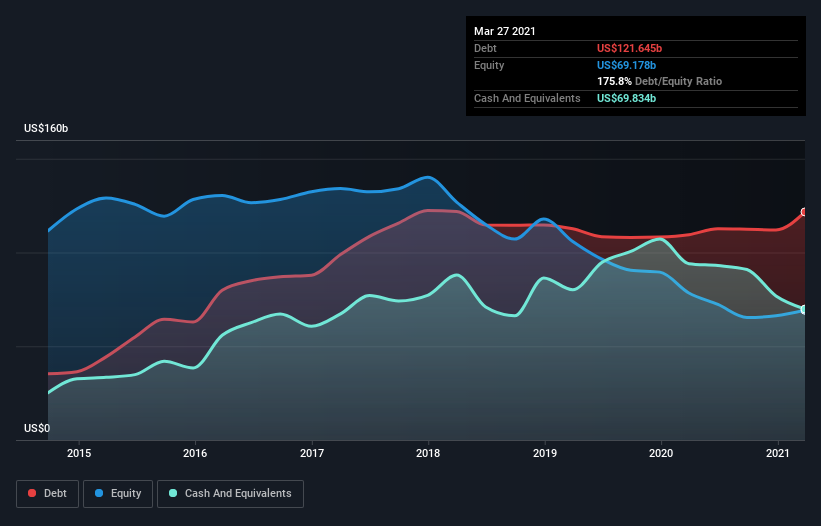David Iben put it well when he said, ‘Volatility is not a risk we care about. What we care about is avoiding the permanent loss of capital.’ When we think about how risky a company is, we always like to look at its use of debt, since debt overload can lead to ruin. We note that Apple Inc. (NASDAQ:AAPL) does have debt on its balance sheet. But the more important question is: how much risk is that debt creating?
When Is Debt Dangerous?
Debt is a tool to help businesses grow, but if a business is incapable of paying off its lenders, then it exists at their mercy. Ultimately, if the company can’t fulfill its legal obligations to repay debt, shareholders could walk away with nothing. While that is not too common, we often do see indebted companies permanently diluting shareholders because lenders force them to raise capital at a distressed price. Of course, the upside of debt is that it often represents cheap capital, especially when it replaces dilution in a company with the ability to reinvest at high rates of return. When we think about a company’s use of debt, we first look at cash and debt together.
View our latest analysis for Apple
What Is Apple’s Debt?
You can click the graphic below for the historical numbers, but it shows that as of March 2021 Apple had US$120.2b of debt, an increase on US$109.5b, over one year. On the flip side, it has US$69.8b in cash leading to net debt of about US$50.4b.

A Look At Apple’s Liabilities
According to the last reported balance sheet, Apple had liabilities of US$106.4b due within 12 months, and liabilities of US$161.6b due beyond 12 months. Offsetting this, it had US$69.8b in cash and US$33.0b in receivables that were due within 12 months. So its liabilities total US$165.1b more than the combination of its cash and short-term receivables.
Of course, Apple has a titanic market capitalization of US$2.48t, so these liabilities are probably manageable. But there are sufficient liabilities that we would certainly recommend shareholders continue to monitor the balance sheet, going forward.
We measure a company’s debt load relative to its earnings power by looking at its net debt divided by its earnings before interest, tax, depreciation, and amortization (EBITDA) and by calculating how easily its earnings before interest and tax (EBIT) cover its interest expense (interest cover). Thus we consider debt relative to earnings both with and without depreciation and amortization expenses.
Apple has a low debt to EBITDA ratio of only 0.50. And remarkably, despite having net debt, it actually received more in interest over the last twelve months than it had to pay. So there’s no doubt this company can take on debt while staying cool as a cucumber. In addition to that, we’re happy to report that Apple has boosted its EBIT by 36%, thus reducing the spectre of future debt repayments. There’s no doubt that we learn most about debt from the balance sheet. But it is future earnings, more than anything, that will determine Apple’s ability to maintain a healthy balance sheet going forward. So if you’re focused on the future you can check out this free report showing analyst profit forecasts.
Finally, while the tax-man may adore accounting profits, lenders only accept cold hard cash. So it’s worth checking how much of that EBIT is backed by free cash flow. During the last three years, Apple generated free cash flow amounting to a very robust 99% of its EBIT, more than we’d expect. That positions it well to pay down debt if desirable to do so.
Our View
Apple’s interest cover suggests it can handle its debt as easily as Cristiano Ronaldo could score a goal against an under 14’s goalkeeper. And that’s just the beginning of the good news since its conversion of EBIT to free cash flow is also very heartening. We think Apple is no more beholden to its lenders, than the birds are to birdwatchers. To our minds it has a healthy happy balance sheet. There’s no doubt that we learn most about debt from the balance sheet. But ultimately, every company can contain risks that exist outside of the balance sheet. For example – Apple has 1 warning sign we think you should be aware of.
At the end of the day, it’s often better to focus on companies that are free from net debt. You can access our special list of such companies (all with a track record of profit growth). It’s free.
Promoted
If you’re looking to trade Apple, open an account with the lowest-cost* platform trusted by professionals, Interactive Brokers. Their clients from over 200 countries and territories trade stocks, options, futures, forex, bonds and funds worldwide from a single integrated account.
This article by Simply Wall St is general in nature. It does not constitute a recommendation to buy or sell any stock, and does not take account of your objectives, or your financial situation. We aim to bring you long-term focused analysis driven by fundamental data. Note that our analysis may not factor in the latest price-sensitive company announcements or qualitative material. Simply Wall St has no position in any stocks mentioned.
*Interactive Brokers Rated Lowest Cost Broker by StockBrokers.com Annual Online Review 2020
Have feedback on this article? Concerned about the content? Get in touch with us directly. Alternatively, email editorial-team (at) simplywallst.com.




